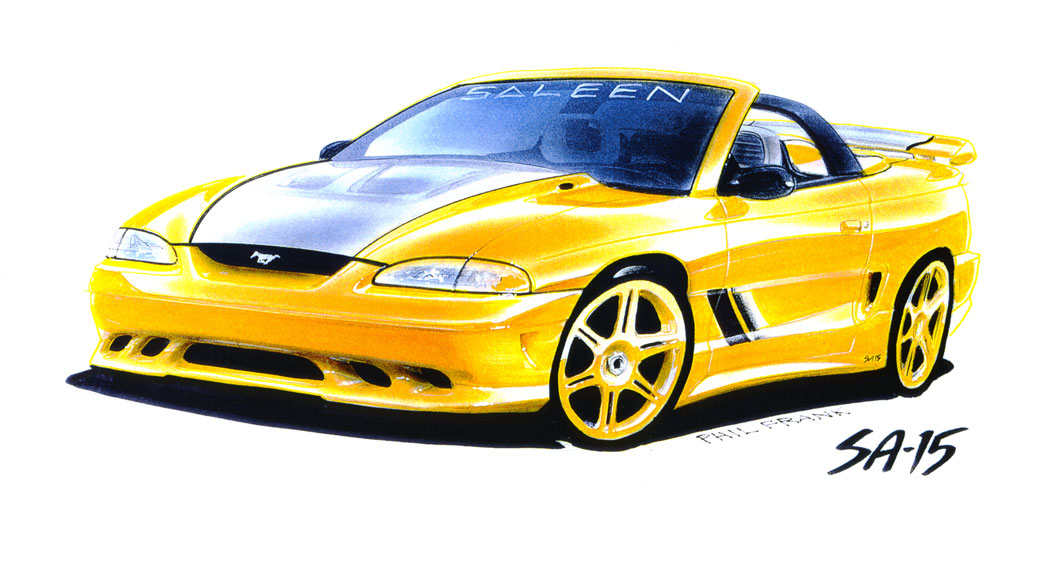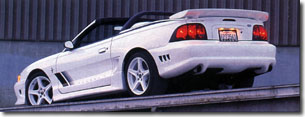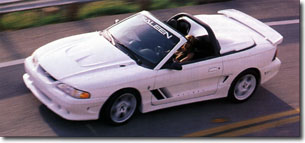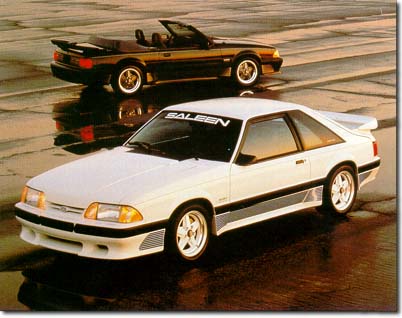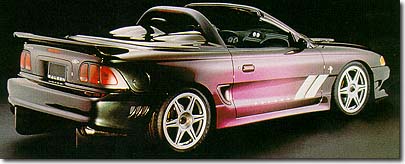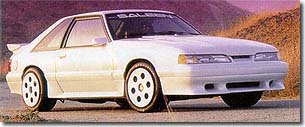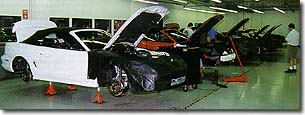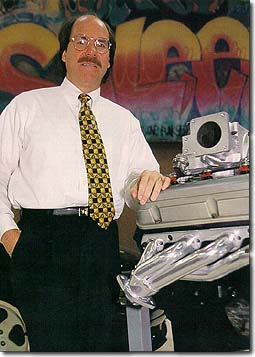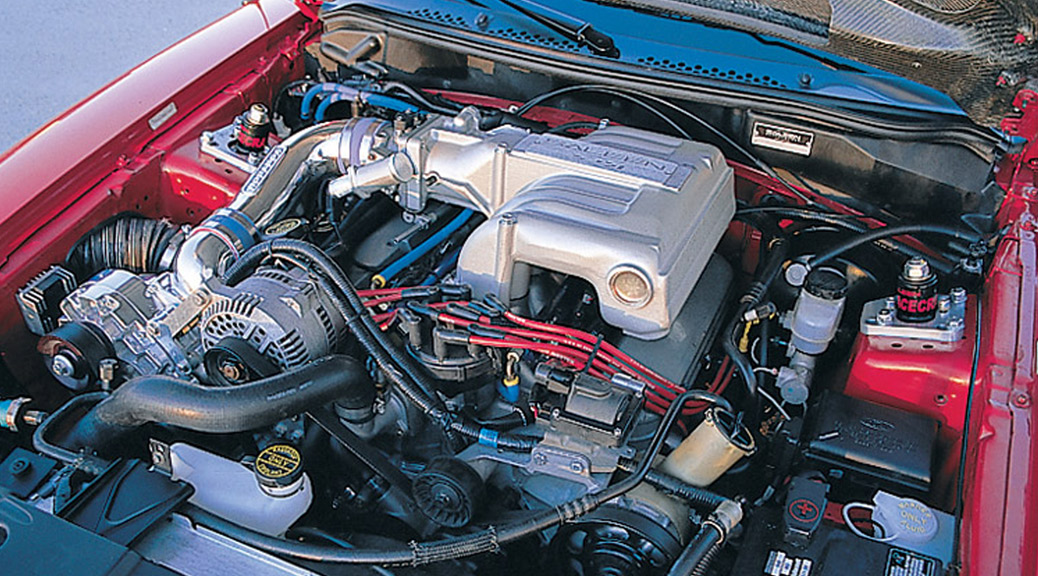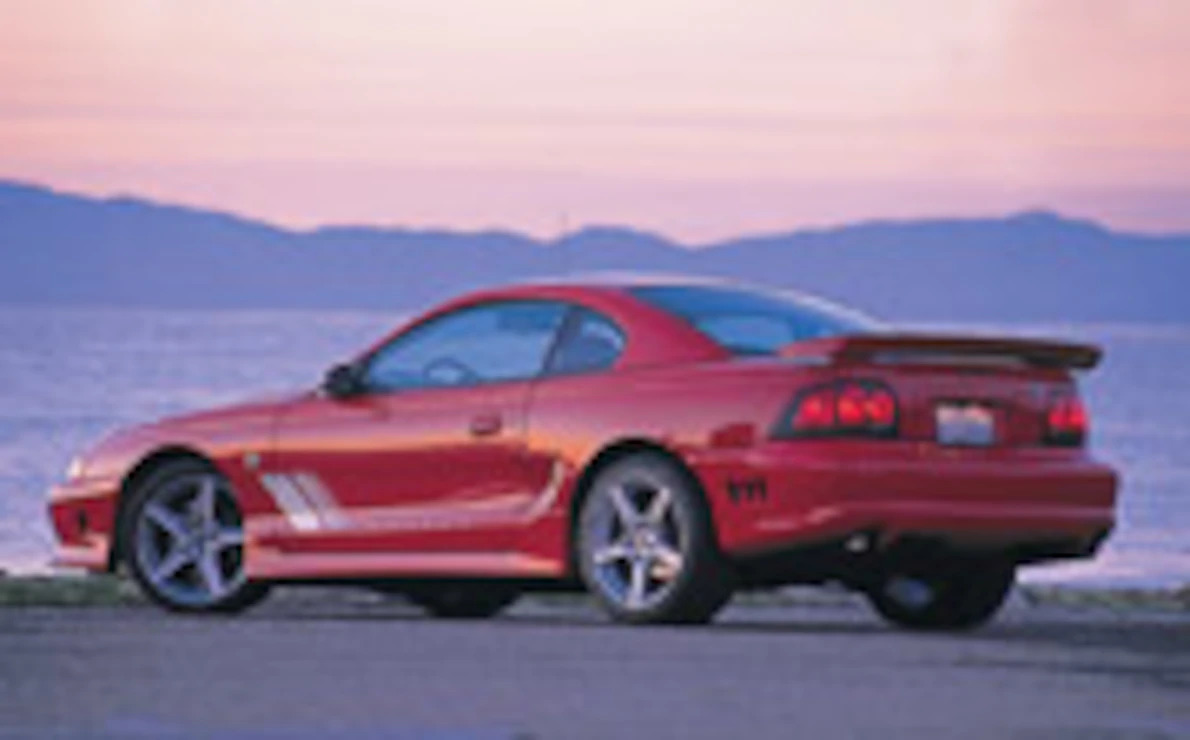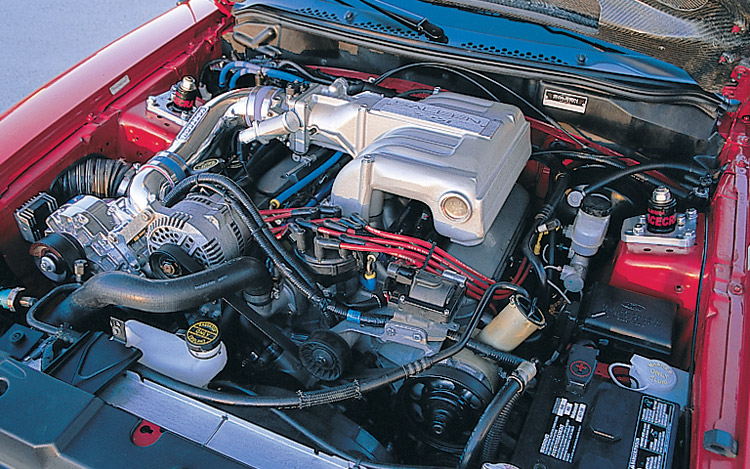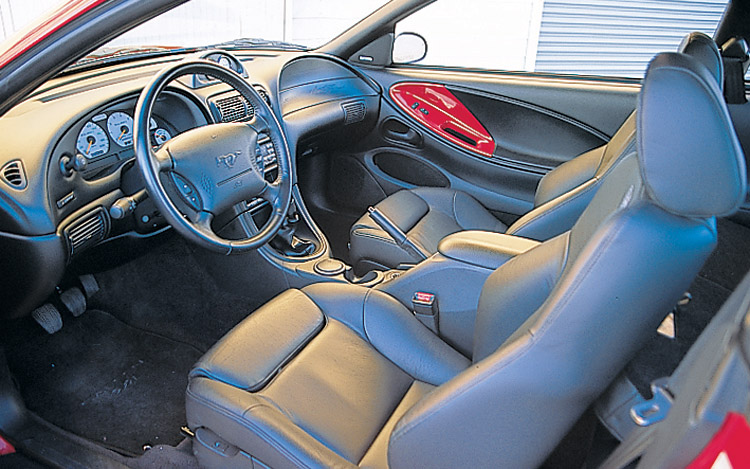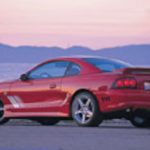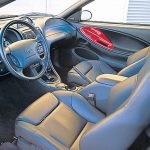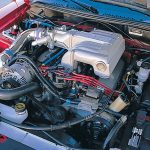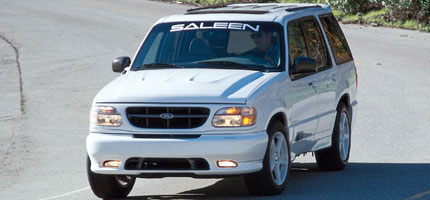LEXINGTON, Ohio — 13 June 1998 — Terry Borcheller, in the No. 56 Saleen/Allen Racing Saleen Mustang, checked out early in the 30-lap, 67.5-mile Mid-Ohio Road Racing Classic World Challenge T1 race for 9.005-second margin of victory over the No. 65 Saleen/Allen Racing Saleen Mustang of teammate Ron Johnson, while Hugh Plumb scored his first series win in the T2 Class.
Borcheller, of Phoenix, Ariz., rocketed from his start on the pole and had a comfortable lead until a lap 12 full-course to clean up debris on the circuit. On the restart, Borcheller checked out for good in the 50 minute, 37.624 second race, leaving the rest of the field to battle for the remaining podium positions.
“It’s real nice having the horsepower to get around traffic,” said Brorcheller. “I love driving the Saleen Mustang. The power is much better, but I really have to take care of the brakes to keep the handling balanced. This was a good race for the Saleen/Allen team.”
Behind Borcheller, teammate Johnson was in a tight battle with David Schardt, in the No. 94 Toyota Motorsports/The Wheel Source Toyota Supra Turbo and Neil Hanneman, in the No. 31 Viper Speed Dodge Viper.
“At the start the Toyota really took off,” said Johnson. “He was pulling me down the straight — and straight-line speed is my strength. I was a little worried but as the race went on I was able to get a handle on the car and be competitive.”
Hanneman also chased Johnson the entire race, but was never able to mount a serious challenge for the runner-up spot, finishing third to capture the final podium position. Paul Brown in the No. 96 H.P. Motorsports Ford Mustang and Jeff Conkel in the No. 7 Kurlin/Applebee’s Porsche 911 followed Hanneman in fourth and fifth, respectively.
“We’re happy to be here on the podium,” said Hanneman. “This is the first race that we felt like most of the bugs were worked out of the car in our setup.”
In the T2 Class, rookie Hugh Plumb raced his No. 16 European Racing Technologies BMW 328is to a 0.411-second margin of victory over veteran Michael Galati .
“This is a dream of mine to race in the World Challenge,” said Plumb. “It’s definitely a bad feeling to drive with them (Galati and Pierre Kleinubing) in your mirrors, but to win is a great feeling, and it’s an honor to be racing with these guys.”
Galati, in the No. 44 RealTime Racing/Comptech Acura Integra R, started on the pole and led until Johannes Van Overbeek, in the No. 23 Last Minute Racing BMW 328is, made a lap-three pass, holding the top spot for six laps until Galati slipped back into the lead on lap 10. For the next nine laps Galati led the 24-car T2 field, but Plumb used his horsepower advantage to take a lead he would never relinquish on lap 20.
“Our car was good the entire race, we just did not have as much straight-line speed as the BMW,” said Galati. “When he passed me, we came into the Keyhole side by side under braking and it was real tight. He had the edge coming onto the straight.”
Earning the final T2 Class podium spot was Kleinbing, in the No. 43 RealTime Racing/Comptech Acura Integra R. Second-fastest qualifier Kleinubing lost several positions in the opening lap, and spent the rest of the race driving his way back onto the podium, ahead of the VanOverbeek in fourth and Jeff McMillin in fifth.
After three races, Johnson leads the T1 Class Drivers’ Championship standings with 84 points, followed by Peter Cunningham, 56, and Borcheller, 53. In the T2 Class, Kleinubing leads with 93 points, followed by Galati, 89, and Van Overbeek, 71.
LEXINGTON, Ohio — Results from Saturday’s 30-lap, 67.5-mile World Challenge race at the Mid-Ohio Sports Car Course, with finishing position, starting position in parentheses, driver, hometown, class, car, laps and reason out.
1. (1), Terry Borcheller, Pheonix, Ariz., T1, Saleen Mustang, 30.
2. (4), Ron Johnson, Wayzata, Minn., T1, Ford Mustang, 30.
3. (5), Neil Hannemann, Livonia, Mich., T1, Dodge Viper, 30.
4. (7), Paul Brown, Omaha, Neb., T1, Ford Mustang Cobra R, 30.
5. (20), Jeff Conkel, Lincoln, Neb., T1, Porsche 911, 30.
6. (8), Jerry Isaacson, Long Grove, Ill., T1, Porsche 911 RSR, 30.
7. (13), Walter M. Swick, Concord, Ohio, T1, BMW M3, 30.
8. (9), David Farmer, Albemarie, N.C., T1, Chevrolet Camaro, 30.
9. (12), Hugh Plumb, Chadds Ford, Pa., T2, BMW 328is, 30.
10. (10), Michael Galati, North Olmsted, Ohio, T2, Acura Integra R, 30.
11. (11), Pierre Kleinbing, Erexim, Brazil, T2, Acura Integra R, 30.
12. (23), Johannes Van Overbeek, Pleasanton, Calif., T2, BMW 328is, 30.
13. (14), Jeff McMillin, Erie, Pa., T2, BMW 328is, 30.
14. (15), Chuck Hemmingson, W. Des Moines, Iowa, T2, Oldsmobile Achieva, 30.
15. (24), Will Turner, Newburyport, Mass., T2, BMW 328i, 30.
16. (17), Lance Stewart, Jupiter, Fla., T2, Acura Integra R, 30.
17. (18), Taz E. Harvey, Danville, Calif., T2, Honda Prelude, 29.
18. (28), Steve Lisa, Scottsdale, Ariz., T2, Oldsmobile Achieva, 29.
19. (22), Charlie Downs, T2, Mazda RX-7, 29.
20. (26), David Rosenblum, Langhorne, Pa., T2, Saturn SC, 29.
21. (16), Alain Chebeir, Pelham, N.Y., T2, BMW 328is, 28.
22. (45), Mark Reed, London, UK, T2, Oldsmobile Achieva, 28.
23. (31), Tom Baker, Wilmington, Del., T1, Eagle Talon, 28.
24. (30), Dick Reed, Hoopeston, Ill., T2, Pontiac Sunfire, 28.
25. (32), Walter Dethier, Warren, Conn., T1, Ford Mustang Cobra R, 28.
26. (35), Alex Krugman, Great Neck, N.Y., T2, Mazda RX-7, 28.
27. (39), Michael Sturm, Grafton, Wis., T2, Honda Prelude, 28.
28. (40), David Bruener, Port Edwards, Wis., T2, Honda Prelude, 28.
29. (27), Brad Creger, St. Croix, Virgin Islands, T2, Acura Integra R, 28.
30. (37), Fred Meyer, Dallas, Texas, T2, Acura Integra R, 28.
31. (36), Grant Lockwood, Cumming, Ga., T2, BMW3, 27.
32. (38), Brian Wade, Newfields, N.H., T2, BMW 328, 26, Mech.
33. (43), Denny Baglier, Butler, Pa., T2, Mazda MX6, 26.
34. (6), Grant Carter, Severn, Md., T1, Chevrolet Camaro, 23, Mech.
35. (21), Pat Nowak, Ann Arbor, Mich., T1, Mustang Cobra, 18, Mech.
36. (25), Jeff Demetri, Omaha, Neb., T1, Ford Mustang, 18.
37. (3), David Schardt, Dayton, Ohio, T1, Toyota Supra Turbo, 14, Mech.
38. (2), Peter Cunningham, West Bend, Wis., T1, Acura NSX, 3, Mech.
39. (19), Walter Puckett, Shelby, N.C., T2, Saturn SC, 3, Mech.
40. (34), A.J. Frank, Bluffton, S.C., T2, Honda Acord, 0, Mech.
41. (33), Chris Reinke, Wilmington, Ohio, T2, Ford Contour, 0, Mech.
42. (41), Alfred DuPont, Kennett Square, Pa., T1, BMW M3, 0, DNS.
43. (46), Reese Cox, Marietta, Ga., T1, Chevrolet Corvette, 0, DNS.
44. (44), Scotty B. White, Puvallup, Wash., T1, Chevrolet Corvette Z-R1, 0, DNS.
45. (42), Chris Wiehle, DeKalb, Ill., T1, Chevrolet Corvette, 0, DNS.
46. (29), Pierre Bareil, Cap Madeleine, Canada, T1, Ford Mustang LX, 0, DNS.
T1 Class time of race: 50 minutes, 57.264 seconds.
T1 Class average speed: 79.482 miles-per-hour
T1 Class Margin of victory: 9.01 seconds
T1 Class fastest race lap: Terry Borcheller, 1:35.019 (85.246 mph)
T1 Class lap leaders: laps 1-30, No. 56 Borcheller
T2 Class time of race: 52 minutes, 13.501 seconds.
T2 Class average speed: 77.549 miles-per-hour
T2 Class margin of victory: .485-second
T2 Class fastest race lap: Pierre Kleinbing, 1:39.260 (81.603 mph)
T2 Class lap leaders: laps 1-2, No. 44 Galati; laps 3-9, No. 23 Van
Overbeek; laps 10-19, No. 44 Galati; laps 20-30, No. 16 Plumb.
World Challenge Drivers’ Championship Points after three races
Touring One Class
Pos., Driver, Car, Points, Purse
1, Ron Johnson, Saleen Mustang, 84, $6,000
2, Peter Cunningham, Acura NSX, 56, $3,000
3, Terry Borcheller, Saleen Mustang 53, $3,500
4, Reese Cox, Chevrolet Corvette, 48, $2,000
5, Neil Hannemann, Dodge Viper, 46, $1,9506,
6, Jeff Conkel, Porsche 911, 42, $1,700
7, Paul Brown, Ford Mustang Cobra R, 41, $1,550
8, David Schardt, Toyota Supra Turbo, 39, $500
9, Bill Cooper, Chevrolet Corvette ZR-1, 134, $3,000
10, Chris Wiehle, Chevrolet Corvette 34, $1,200
11, Walter Dethier, Ford Mustang Cobra R, 34, $1,050
12, David Farmer, Chevy Chevrolet Camaro, 33, $1,050
13, Walter M. Swick, BMW M3, 31, $650
14, Grant Carter, Chevrolet Camaro, 30, $1,000
15, Jeff Demetri, Ford Mustang, 30, $500
16, Bobby Archer, Dodge Viper, 25, $1,200
17, Randy Roatch, Porsche 911, 21, $850
18, Stuart Jones, Pont Firebird, 20, $750
19, Jerry Isaacson, Porsche 911 RSR, 20, $750
20, Alfred DuPont, BMW M3, 19, $650
21, Kenneth Lubash, Chevrolet Camaro, 19, $650
22, Pierre Bareil, Ford Mustang LX, 17, $500
23, Tom Baker, Eagle Talon, 17, $500
24, Bob Schiesser, Ford Mustang, 14, $500
25, Pat Nowak, Ford Mustang Cobra, 14, $500
26, Michael Pettiford, Chevrolet Chevrolet Camaro, 14, $500
27, Scotty B. White, Chevrolet Corvette Z-R, 114, $0
28, Peter Polli, Chevrolet Corvette, 13, $0
29, Guy Pine Pavageau, Chevrolet Camaro, 12, $0
30, Darren Law, Ford Mustang, 12, $0
31, Cliff Nystedt, Chevrolet Corvette, 11, $0
32, Thomas Safar II, Chevrolet Corvette ZR-1, 9, $0
33, Kim Baker, Chevrolet Corvette Z-R1, 9, $0
34, Doug Johnson, Chevrolet Corvette, 8, $0
Touring Two Class
Pos., Driver, Car, Points, Purse
1, Pierre Kleinbing, Acura Integra R, 93, $7,200
2, Michael Galati, Acura Integra R, 89, $6,000
3, Johannes Van Overbeek, BMW 328is, 71, $3,050
4, Hugh Plumb, BMW 328is, 68, $4,150
5, Lance Stewart, Acura Integra R, 59, $1,950
6, Will Turner, BMW 328i, 54, $1,700
7, David Rosenblum, Saturn SC, 49, $1,750
8, Taz E. Harvey, Honda Prelude, 49, $1,500
9, Alain Chebeir, BMW 328is, 47, $1,250
10, Chuck Hemmingson, Oldsmobile Achieva, 43, $1,750
11, Mark Reed, Oldsmobile Achieva, 42, $1,000
12, Walter Puckett, Saturn SC, 38, $1,200
13, Jeff McMillin, BMW 328is, 35, $850
14, Steve Lisa, Oldsmobile Achieva, 32, $1,000
15, Jim Lovett, BMW 328i, 30, $650
16, Brad Creger, Acura Integra R, 27, $0
17, Fred Meyer, Acura Integra R, 25, $500
18, Steve Lisa, Oldsmobile Calis, 23, $500
19, Charlie Downs, Mazda RX-7, 15, $500
20, Tom Kelly, Volkswagon GTI, 14, $0
21, Dino Hamilton, Dodge Neon, 14, $0
22, Fred Pignataro, Ford Contour SVT, 12, $0
23, Dick Reed, Pontiac Sunfire, 11, $0
24, Alex Krugman, Mazda RX-7, 11, $0
25, Chris Reinke, Ford Contour, 10, $0
26, Manny Matz, Mazda RX-7, 10, $0
27, A.J. Frank, Honda Acord, 9, $0
28, Michael Sturm, Honda Prelude, 9, $0
29, David Bruener, Honda Prelude, 8, $0
30, Grant Lockwood, BMW Z3, 8, $0
31, Walter Markes Jr., BMW 325is, 7, $0
32, Hugh Stewart, Volkswagon Jetta, 6, $0
33, Richard Ellinger, Mercedes-Benz 190, 5, $0
34, Brian Wade, BMW 328, 4, $0
35, Denny Baglier, Mazda MX6, 3, $0

